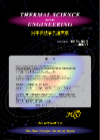All issues

Volume 31 (2023)
- Issue 4 Pages 31-
- Issue 3 Pages 19-
- Issue 1 Pages 1-
Volume 31, Issue 4
Displaying 1-3 of 3 articles from this issue
- |<
- <
- 1
- >
- >|
-
Masanori MONDE, Yuhichi MITSUTAKE2023Volume 31Issue 4 Pages 51-68
Published: 2023
Released on J-STAGE: April 11, 2024
JOURNAL FREE ACCESSQuenching for high temperature material with liquid is a familiar cooling technique that has been used for a long period to quench metals. Nevertheless, it is no exaggeration to say that the factors that determine the onset of rapid cooling remain unknown. One of the reasons for this is that the phase change during cooling is an unsteady phenomenon with a very short transition time from film boiling to nucleate boiling. This study first focuses on the short period of time immediately after the immersion of a hot solid into a liquid, and derives an exact solution for the heat flux between the solid and liquid under the condition that the heat transfer from the solid to the liquid during this time is dominated by heat conduction. A new proposal is made that the initial temperature of the solid at which the surface heat flux q(t) reaches exactly the critical heat flux qc during immersion cooling at a critical time tc* (Eq. (1)) defined for the cooling water temperature is the temperature at which quench begins. This proposal is applied to the other results of previous studies on the quench temperature during immersion cooling of three different geometries, i.e., sphere, cylinder and plate, and its validity is discussed.View full abstractDownload PDF (1943K) -
Yosuke KAWAMURA2023Volume 31Issue 4 Pages 41-49
Published: 2023
Released on J-STAGE: April 11, 1998
JOURNAL FREE ACCESSDownload PDF (2587K) -
Ayumu NAGASHIMA, Takashi FUKUE2023Volume 31Issue 4 Pages 31-40
Published: 2023
Released on J-STAGE: April 11, 2024
JOURNAL FREE ACCESSThis study describes a forced convection heat transfer coefficient on a heat transfer surface in the flow separation area by pulsating flow. The effectiveness of flow pulsation on heat transfer enhancement in the flow separation area has already been reported. An understanding and a performance modeling of the heat transfer coefficient becomes essential to apply the pulsating flow to the thermal equipment. This paper investigated the relationship between the pulsating flow condition and the heat transfer on the heating surface sandwiched between two square cross-section channels and where flow separation was caused through 3D-CFD analysis. In the range of the paper, the research found that the pulsating flow's heat transfer performance on the flow separation area is affected by the time-averaged Reynolds number and the pulsating frequency. The prediction formula can be developed to calculate the time-averaged Nusselt number using the pulsating Strouhal number.View full abstractDownload PDF (2565K)
- |<
- <
- 1
- >
- >|